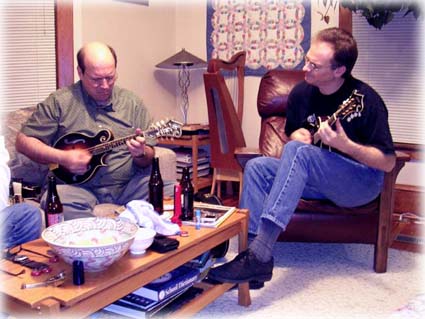« Articulate Articulations |
Main
| Best of JM: 4 and 7. The Committal Notes. »
 September 8, 2011 | Approaching Improvisation September 8, 2011 | Approaching Improvisation
It's a frequent question. "How do I improvise? How do I make up music on my instrument that doesn't embarrass me in front of others?" Think of the reckless abandon of youngsters singing on a playground, making up songs, no inhibitions, no musical "rules," maybe not a lot of aesthetic depth, but underneath it all, simple, unadulterated joy. Think of the over-studied musician, the Scale Meister veteran, loaded with pentatonic fuel and gattling gun arpeggios. Loads of fast, but soulless notes.
There's a happy medium in there somewhere, the meld of both heart and brain. We offer five ingredients to ponder in developing your own improvisational arsenal and jazz voice. You really need to tackle developing this skill from multiple angles.

Learn modes and scales and apply them to "key centers." Scales are the basic building block of melody, and knowing how they lay out in your head is equally important to knowing them in your fingers. Just like words make up sentences in language, scales make up melodies. There's improvisational efficiencies in matching scales to key centers. It's a terrific jumping off point. Knowing you just modulated temporarily from Eb Major to G Major is great, especially if you know an Eb scale and a G scale.
Play the chord tones (learn arpeggios). Scales contain "filler" when it comes to communicating the vertical (chord) structure of a song. The meat tones are the ones that match up to the chord members. Know where these are and matching them up with longer notes, resting points, and accented tones help communicate the songs harmonic content. It's not just the accompaniment that is responsible for laying this down, it needs to be communicated in the solo itself.
Understand the concept "gravity" notes and "approach" tones. The chords are great, but you still need linear motion. There are entire folk genres based on nothing but melody, devoid of any kind of chord structure. You simply can't ignore the importance of forward motion, "pull" from one note to the next. 7 leads to 1. 4 leads to 3. raised 4 leads to 5. These give direction, communicate intention. The more you understand and incorporate this concept into your playing, the less likely you are to "wander."
Quote artists' licks, and move them around the fretboard. Copy? Plagiarize? You won't be the first. Learning morsels of other artist's solos, even in short phrases or segments is a tremendous starting point. Find something you like and try to transpose it. Use the same scale note relationships as something to build off, or even quote directly. Ironically, if you steal enough material, you end up developing your own voice. That's not theft, that's art!
All of the above. Probably the most important idea is to incorporate ALL these ideas. If all you do is learn scales, when you solo, you sound like someone... playing scales. They are a starting point. Same with arpeggios, you can make a solo sound like nothing but a warmup routine, and not an aesthetic statement. Focusing on the intellect, the math of gravity and approach notes too much robs the soul. Sometimes you need to go back to just "blowing."
Your practice routine also needs to include all these elements. Check out our Downloads for starters. Spend some time on them, but don't forget to get some accompaniment tracks and apply. Sometimes you do need to put the scale book away, sometimes you need to come back. Cycle around to all of these and your confidence and ability to improvise will flourish.
Further:
Don Stiernberg on scale degree "feelings"
Improvisation: Pattern Based VS. Theory Based
Critical Decisions in Improvising: 'Gravity' Notes
Suspicion of Melodic Intent
Spelling out the chords melodically
Posted by Ted at September 8, 2011 4:04 AM

Disclaimer: In the 'Information Age' of the 21st Century,
any fool with a computer, a modem, and an idea can
become a self-professed 'expert." This site does not
come equipped with 'discernment.'
|



